Our automatic strainer systems for filtration >75 microns are described in our article Model 2596 Automatic Strainers; this article describes our automatic tubular backwashing filtration systems for particle retentions as fine as 2 microns. While both the 2596 and tubular backwashing designs rely on system differential pressure to backwash the filter element, the tubular backwashing design can retain much finer particles and is a scalable design to enable fine filtration of high flow rates.
Finer retention capability means that these systems are not typically replacing duplex pipeline strainers (coarse filtration), rather bag filter and filter cartridge systems which are typically applied to the 2 to 1,000 micron range of retention. When compared with disposable media systems, tubular backwashing filtration systems reduce costs associated with labor and downtime by reducing replacement, handling and disposal of disposable media. The "cleaned-in place" tubular backwashing filter design supports an environmentally conscious approach to waste reduction.
Tubular backwashing filters are designed for operation at pressures up to 1,000 PSIG and are used mostly for industrial water applications, hot condensate, chiller water, paper mill "white water", clean-in-place water and a wide variety of automated processes which require a stable pressure or a fine level of filtration to protect the equipment and process downstream of the filter system.
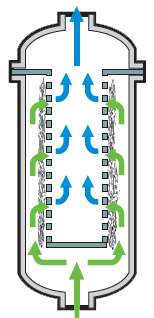
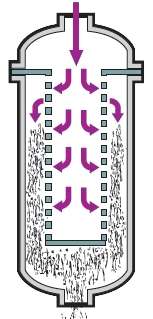 How
Tubular Backwashing Filters Work
How
Tubular Backwashing Filters Work
Unfiltered liquid enters the filter station, passing through the sealed filter element; particles that are too large either accumulate on the element surface or fall to the bottom of the vessel chamber.
Backwashing of the element occurs when the 3-way inlet valve actuates, closing-off the inlet and opening the drain port. The actuation can be performed manually for single station systems and can be automatically actuated (pneumatically or electrically) using a programmable timer or differential pressure switch.
The backpressure of the system causes the flow to reverse through the element, using the already filtered liquid to backwash through the element and flush the vessel clean. A system pressure of 45 PSIG is required for efficient cleaning.
The time required for this process depends upon the characteristics of the application, but is typically only a few seconds per filter station and <2% of the flow rate.
Most tubular filtration systems consist of multiple filter stations installed in parallel. Once the backwashing process is initiated, each filter station will undergo the backwashing cycle in series to ensure sufficient flow and minimal pressure loss during the backwashing cycle.
The illustration below illustrates a matrix of 1 x 6 filter stations, 5 in filtration mode and 1 in backwash mode. Each filter station is connected to a common inlet, outlet and drain manifold. Tubular backwashing filter systems can have as many as (14) filter stations with each station supporting up to 150 GPM.
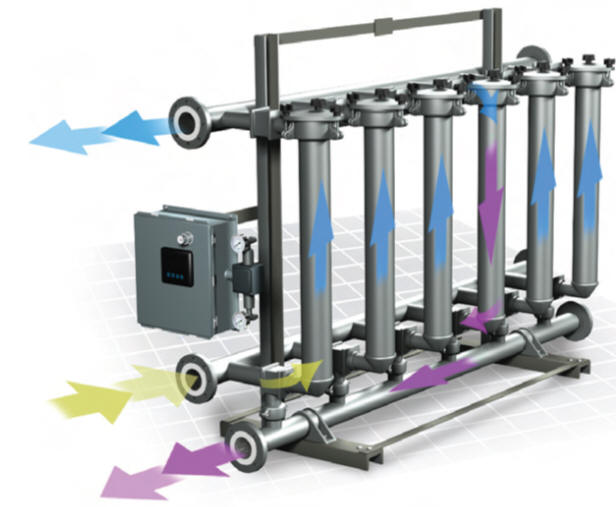
Tubular backwashing filter systems can be provided with "blank stations"; essentially fabricating the manifolds long enough and having capped connections to enable additional filter stations to be added at a later date. Another way of expanding flow rate capacity is to connect multiple systems together and integrating the controls so that they function as a single system.
The design is not constrained to a linear arrangement of 1 x 14 filter stations, they can be arranged in a 2 x 7 matrix, reducing the filtration system length by 50% and only slightly increasing its width.
If the application requires a separate liquid source for backwashing the filter element, that can be accommodated by adding a 4th manifold and a 2nd set of control valves. This might be desirable when the filtered liquid is too valuable or hazardous to use as the backwashing liquid. Using an external source of backwashing liquid is also required when the system pressure is <45 PSIG or when the process cannot tolerate slight flow rate fluctuations during the backwashing process.
The AFR configuration is example of a compact arrangement of tubular backwashing filter stations, consisting of 4 to 8 filter stations encircling a custom designed valve used to isolate and backwash one filter station in sequence. An advantage of this configuration is that it takes up much less floor space than a comparable 2 x 2 or 2 x 4 filter system and it has far fewer parts to enhance the reliability of the filter system. As with the matrix design, the AFRs can be connected together and operated as a single system in support of higher flow rate applications.

Following is a physical comparison of a compact 8-chamber AFR compared to an 8 chamber matrix layout; the AFR uses (16) fewer automated valves and is only about 1/3 of the floor space!
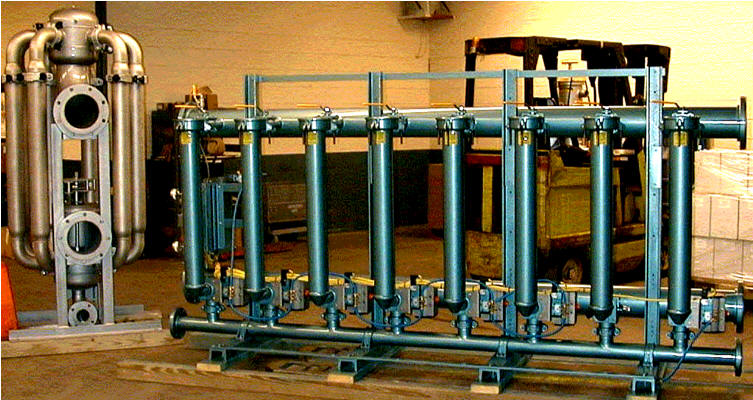
Filter Element Design
The requirements of your application will determine the design of the internal element which is offered in 1, 3 and 7 chamber designs. All three designs have a single seal and are physically (1) “unit” however additional chambers increase the total surface area and therefore increasing the open area ratio for a given size filter station. Depending upon the liquid viscosity and other factors, incorporating backwashing flow diffusers is an option to maximize backwashing efficiency and minimize backwashing cycle time.
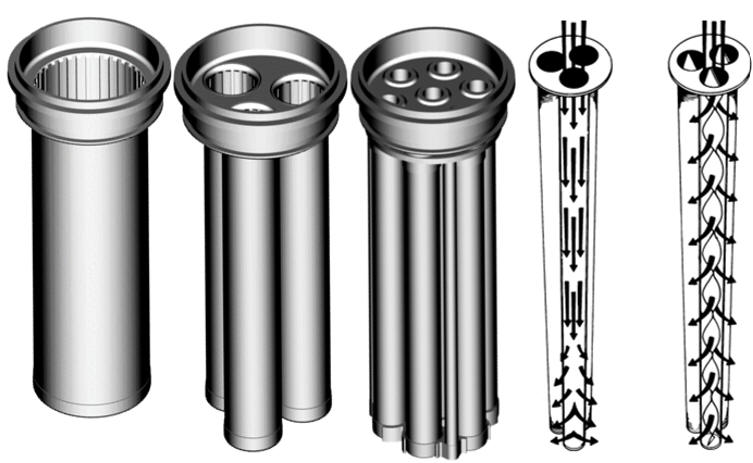
There are many variations and options that we do not show online, please fill-out our automatic filter system inquiry form for assistance, we typically reply the same day or within 24 hours. You can also simply call us or use the website’s online chat option.